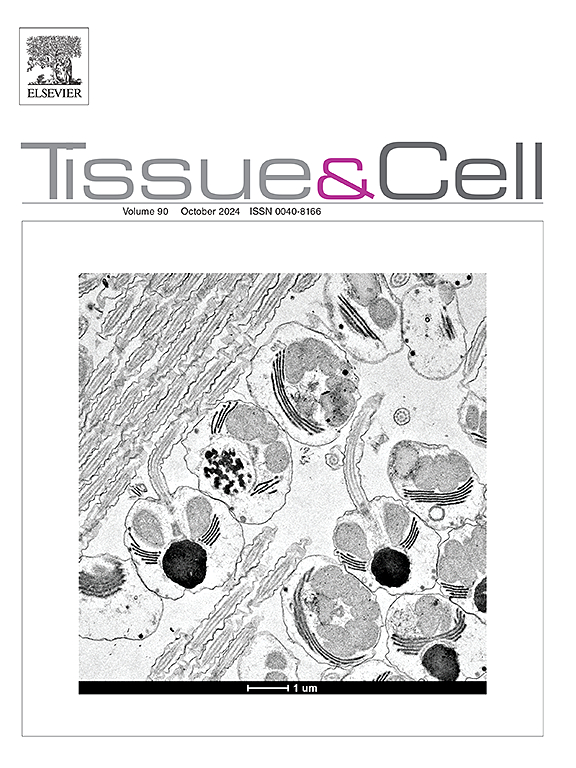PCSK9 exacerbates sevoflurane-induced neuroinflammatory response and apoptosis by up-regulating cGAS-STING signal
IF 2.7
4区 生物学
Q1 ANATOMY & MORPHOLOGY
引用次数: 0
Abstract
Background
Postoperative cognitive dysfunction (POCD) is a postoperative complication that can be induced by anaesthesia. PCSK9 has been shown to have a role in neuronal development and apoptosis. However, PCSK9 has not been studied in sevoflurane-induced POCD-related disorders.
Objective
To explore whether PCSK9 can exacerbate sevoflurane-induced neuroinflammatory response and apoptosis by up-regulating cGAS-STING signalling.
Methods
A POCD model was constructed by stimulating BV2 microglia with Sevoflurane. CCK8 was used to detect the cell viability, and immunofluorescence was used to observe the expression of microglial activation markers (Iba-1, CD11b) and BDNF to determine the activation of BV2 microglia. Cell proliferation was measured by EDU staining, and apoptosis was analyzed by flow cytometry and western blot. The levels of inflammatory cytokines, ROS, MDA, SOD and CAT were respectively detected by ELISA, DCFH-DA staining, and kits to determine the neuroinflammation and oxidative stress of cells. Mitochondrial ROS, mitochondrial membrane potential, mtDNA and ATP levels were measured to evaluate cellular mitochondrial function.
Results
Transfection of si-PCSK9 inhibited Sevoflurane-induced microglial activation and restored cellular viability, promoted cell proliferation, inhibited apoptosis and neuroinflammation, decreased ROS and MDA levels in the cells while up-regulating the levels of SOD and CAT, thus inhibiting oxidative stress, restored the mitochondrial membrane potential to normal and decreased mitochondrial ROS and mtDNA levels and increased ATP production, thereby alleviating mitochondrial dysfunction. Moreover, PCSK9 depletion also down-regulated the expression of cGAS and STING to inactivate cGAS-STING signaling. However, cGAS overexpression partially reversed the effects of si-PCSK9.
Conclusion
PCSK9 exacerbates sevoflurane-induced neuroinflammatory response and apoptosis by upregulating cGAS-STING signaling.
PCSK9通过上调cGAS-STING信号加重七氟醚诱导的神经炎症反应和细胞凋亡。
背景:术后认知功能障碍(POCD)是一种可由麻醉引起的术后并发症。PCSK9已被证明在神经元发育和凋亡中起作用。然而,PCSK9在七氟醚诱导的pocd相关疾病中尚未被研究。目的:探讨PCSK9是否通过上调cGAS-STING信号通路加重七氟醚诱导的神经炎症反应和细胞凋亡。方法:用七氟醚刺激BV2小胶质细胞建立POCD模型。用CCK8检测细胞活力,用免疫荧光法观察小胶质细胞活化标志物(Iba-1、CD11b)和BDNF的表达,确定BV2小胶质细胞的活化情况。EDU染色检测细胞增殖,流式细胞术和western blot检测细胞凋亡。采用ELISA、DCFH-DA染色、试剂盒检测各组细胞炎症因子、ROS、MDA、SOD、CAT水平,检测细胞的神经炎症和氧化应激。测定线粒体ROS、线粒体膜电位、mtDNA和ATP水平,评价细胞线粒体功能。结果:转染si-PCSK9可抑制七氟醚诱导的小胶质细胞活化,恢复细胞活力,促进细胞增殖,抑制细胞凋亡和神经炎症,降低细胞内ROS和MDA水平,上调SOD和CAT水平,从而抑制氧化应激,使线粒体膜电位恢复正常,降低线粒体ROS和mtDNA水平,增加ATP生成,从而缓解线粒体功能障碍。此外,PCSK9缺失还下调了cGAS和STING的表达,使cGAS-STING信号通路失活。然而,cGAS过表达部分逆转了si-PCSK9的作用。结论:PCSK9通过上调cGAS-STING信号通路加重七氟醚诱导的神经炎症反应和细胞凋亡。
本文章由计算机程序翻译,如有差异,请以英文原文为准。
求助全文
约1分钟内获得全文
求助全文
来源期刊

Tissue & cell
医学-解剖学与形态学
CiteScore
3.90
自引率
0.00%
发文量
234
期刊介绍:
Tissue and Cell is devoted to original research on the organization of cells, subcellular and extracellular components at all levels, including the grouping and interrelations of cells in tissues and organs. The journal encourages submission of ultrastructural studies that provide novel insights into structure, function and physiology of cells and tissues, in health and disease. Bioengineering and stem cells studies focused on the description of morphological and/or histological data are also welcomed.
Studies investigating the effect of compounds and/or substances on structure of cells and tissues are generally outside the scope of this journal. For consideration, studies should contain a clear rationale on the use of (a) given substance(s), have a compelling morphological and structural focus and present novel incremental findings from previous literature.
文献相关原料
公司名称
产品信息
索莱宝
MDA kit
索莱宝
propidium iodide
索莱宝
CAT kit
索莱宝
SOD kit
 求助内容:
求助内容: 应助结果提醒方式:
应助结果提醒方式:


